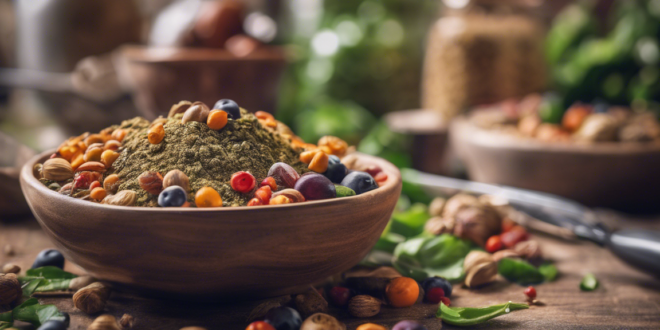Superfood Secrets Unveiled: A Comprehensive Guide to Nutrient-Dense Nutrition
In the ever-evolving world of nutrition, the term “superfood” has become a buzzword that captures the imagination of health-conscious individuals seeking optimal wellness. But what exactly makes a food worthy of this superhero-like designation? Dietitians and nutrition experts have been diving deep into the science behind these nutrient powerhouses, offering insights that can transform the way we approach our daily diet.
Defining the Superfood: More Than Just a Trendy Label
Contrary to popular belief, “superfood” is not an official scientific classification. Instead, it’s a marketing term that has gained significant traction in recent years. Dietitians define superfoods as nutrient-rich foods that offer exceptional health benefits beyond basic nutritional requirements. These foods are typically packed with vitamins, minerals, antioxidants, and other bioactive compounds that can potentially reduce the risk of chronic diseases and support overall health.
The Nutritional Powerhouses: Top Superfoods Explained
1. Berries: Nature’s Antioxidant Champions
Blueberries, strawberries, and acai berries top the list of superfood superstars. These small fruits are nutritional giants, loaded with antioxidants that combat oxidative stress and inflammation. A single serving can provide more protective compounds than many other foods, making them a crucial addition to a health-conscious diet.
2. Leafy Greens: The Nutrient-Dense Green Giants
Kale, spinach, and Swiss chard are more than just salad ingredients. These leafy powerhouses are rich in vitamins A, C, E, and K, along with minerals like calcium and iron. They offer remarkable benefits for heart health, bone strength, and cellular protection.
3. Fatty Fish: Omega-3 Miracle Workers
Salmon, mackerel, and sardines are nutritional treasures. Packed with omega-3 fatty acids, these fish support brain function, reduce inflammation, and promote heart health. Research suggests that regular consumption can lower the risk of cardiovascular diseases and support mental well-being.
The Science Behind Superfoods
Nutritional experts emphasize that no single food can provide complete nutrition. Superfoods are most effective when incorporated into a balanced, varied diet. The key lies in understanding the unique nutritional profile of each food and how it contributes to overall health.
Antioxidants: The Protective Compounds
At the core of superfood benefits are antioxidants – compounds that neutralize harmful free radicals in the body. These molecular defenders protect cells from damage, potentially reducing the risk of chronic diseases like cancer, diabetes, and heart disease. Foods like dark chocolate, green tea, and turmeric are particularly rich in these protective compounds.
Incorporating Superfoods into Your Daily Diet
Practical integration is key to reaping the benefits of superfoods. Nutritionists recommend:
– Adding berries to morning smoothies
– Incorporating leafy greens into daily meals
– Replacing processed snacks with nuts and seeds
– Choosing whole foods over supplements
Debunking Superfood Myths
1. Myth: Superfoods are expensive and exotic
Reality: Many affordable, locally available foods are nutritional powerhouses. Eggs, sweet potatoes, and beans are excellent examples of nutrient-dense foods that don’t break the bank.
2. Myth: More is always better
Reality: Moderation and variety are crucial. Overconsumption of any single food can lead to nutritional imbalances.
Special Considerations: Superfoods and Individual Nutrition
Dietitians stress the importance of personalized nutrition. Factors like age, health conditions, and individual metabolic differences impact how our bodies process and benefit from different foods. Consulting a healthcare professional can help create a tailored nutrition plan that incorporates superfoods effectively.
The Future of Nutritional Science
Ongoing research continues to uncover the complex interactions between food and human health. Emerging studies are exploring how specific nutrients can impact genetic expression, potentially offering more targeted nutritional strategies for disease prevention and wellness optimization.
Conclusion: A Holistic Approach to Nutrition
Superfoods are not magical cure-alls but valuable components of a comprehensive approach to nutrition. By understanding their benefits and integrating them thoughtfully into our diet, we can take significant steps toward improved health and well-being.
Remember, the most powerful superfood is a balanced, varied diet combined with a healthy lifestyle. Nutrition is a journey, not a destination.
 Good Calories Guide GoodCalories Guide focuses on nutrition, healthy eating, and overall wellness. The site offers practical insights into evidence-based dietary practices, including tips for specific lifestyles such as veganism, keto, and family-friendly meal planning. It also addresses unique nutritional needs for individuals with conditions like diabetes or food allergies, while providing quick and accessible recipes to make healthy living a sustainable and enjoyable choice.
Good Calories Guide GoodCalories Guide focuses on nutrition, healthy eating, and overall wellness. The site offers practical insights into evidence-based dietary practices, including tips for specific lifestyles such as veganism, keto, and family-friendly meal planning. It also addresses unique nutritional needs for individuals with conditions like diabetes or food allergies, while providing quick and accessible recipes to make healthy living a sustainable and enjoyable choice.


